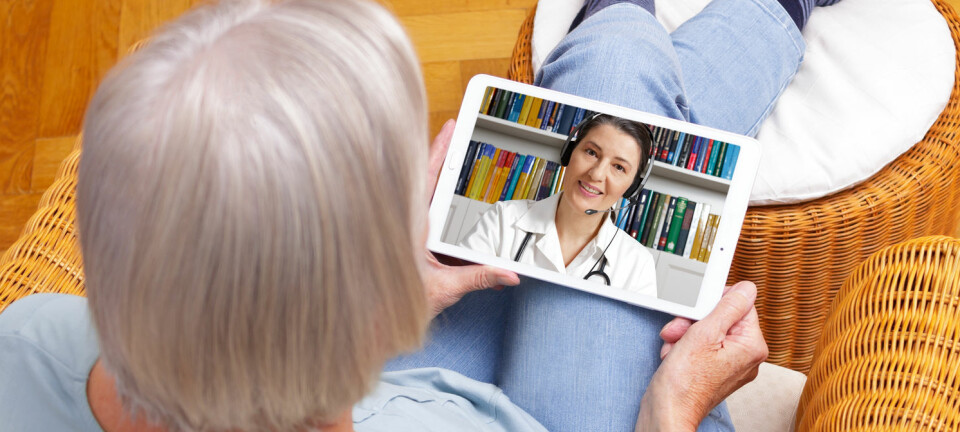This article was produced and financed by Norwegian centre for E-health research - read more

The corona crisis may force municipalities to give more digitalised health services
GPS watches and automatic drug dispensers. If you are old and live in a large municipality, chances are greater that you have been offered these technologies. The corona crisis however, may force health services in all of Norway to become more digital.
Connected care technology will make everyday life easier and safer for the elderly who live at home or in nursing homes. Well known examples are GPS watches that show where the user is, sensors that send an alert if a person falls, or automatic medicine dispensers that "tell you" when to take your pills.
An evaluation of the tools offered by the Norwegian Program for Connected Care Technologies now shows that there are differences in how useful the municipalities think they have been. There are thus differences in to what extent the municipalities have introduced these technologies.
Researchers Elin Breivik and Gunn-Hilde Rotvold at the Norwegian Centre for E-health Research have, in collaboration with a researcher from Sintef Digital, investigated the use of these technologies in 211 municipalities.
Size matters
The main findings of the survey show that the size of the municipality plays a role to whether the service is seen as useful. It takes time to introduce new technology and the processes are often complicated. Many municipalities say that they are dependent on support in the years to come.
"Even though they receive support from the national program, there are challenges. The introduction is more successful for the larger municipalities. But it's difficult to create one model for everyone, when we know how different the municipalities are", says Elin Breivik.
Many small municipalities simply lack resources for connected care technology.

Changes throughout the organization
The large Norwegian municipalities with more than 20,000 inhabitants have consistently used more of the program's tools, than the medium-sized ones between 5,000 and 20,000 inhabitants and the small ones with less than 5,000 inhabitants.
Small municipalities have less resources and less access to project management expertise and are therefore more dependent on support from the program.
"These projects do not only affect the health service. The IT departments must also develop their portfolio at the same time. When new technology is to be introduced, health professionals and IT people must work together, which requires good coordination and a willingness to learn from each other. The change processes do not only take place in the health and care service", says Gunn-Hilde Rotvold.
The users also have completely different needs. It is difficult to create a recipe that suits everyone. The health service in the municipalities must therefore map the needs and adapt the technology to each user and the local service.
Differences in distance
Demography and geography also play a role.
Some municipalities have more elderly people than others or a more spread out population. It is not certain that the technology suitable for a big city is suitable for a stretched-out municipality.
"Digital surveillance of cameras can be very relevant for both stretched-out municipalities and big cities. You can save a lot of driving in less populated areas and avoid traffic and queues in big cities", Breivik emphasizes.

Must have good training
The home care service needs to know how to use the technology. They must have routines and training, and assess whether the elderly benefit from the technology at all.
"In addition, the user must learn to become digital. We have seen that this takes time, as heavy processes often do. Everything must be anchored in the management and in the health service", Elin Breivik points out, and adds:
"Many of our informants said that it takes a long time to make the technology work, also because there are so many different types of technology available."
One of the researchers' tips for the policy program is therefore that they continue to recommend which technology the municipalities should start with.
Changes in the corona period
One of the tools in the program is access to network arenas. The municipalities have met to support each other, exchange experiences, and enter into cooperation agreements. They have been very happy with this.
"Those we have talked to say that physical meeting places have been very good, but also video conferencing has become more relevant", the researchers point out.
Video conferencing is the key word for what has happened during this year. The corona crisis has brought a rapid digitalisation in the municipalities and reduced the physical meeting places.
"All parts of the health service have digitized at full speed. New technology for residents and relatives has also been tried out in nursing homes, for example using iPads. This is completely new", according to the researchers, who have only observed this development.
"It will be interesting to see if it goes back to normal after all the restrictions are over", says Elin Breivik
Will research the effects
Perhaps the corona crisis means that the municipalities are forced to use more technology, and that the small municipalities also gain momentum in the introduction of technology. Digital tools have become central to preventing infection, and then it does not matter if you are a small or large municipality.
"Digital supervision seems to replace physical meetings. Cameras and sensors warn if something is not going well at the users' homes at night and we see increasing use of video to communicate. But there are several aspects to this, we do not know if more elderly people will be lonely as a consequence", say Elin Breivik and Gunn-Hilde Rotvold.
In their next project they will study the effects of connected care technology in the municipalities.
———


































